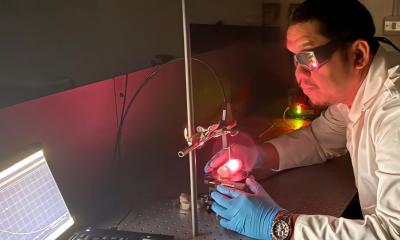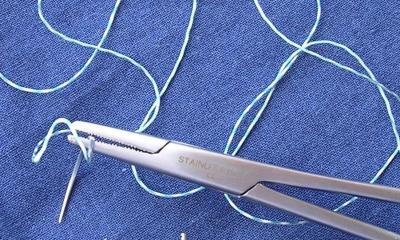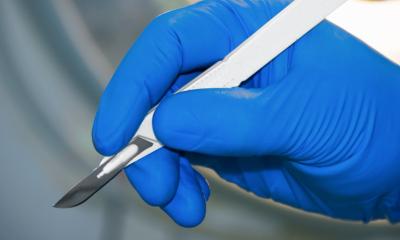Video • No more staples
‘Bio-glue’ could mean end to surgical sutures
Biomaterial engineers at Western University and University of Manitoba have developed the first-ever hydrophobic (water-hating) fluid, which instantly displaces body fluids surrounding an injury allowing for near-instantaneous gelling, sealing, and healing of injured tissue.
Western biomaterials expert Kibret Mequanint—in partnership with Malcolm Xing from University of Manitoba—has developed the first-ever hydrophobic (water-hating) fluid, which displaces body fluids surrounding an injury allowing for near-instantaneous gelling, sealing and healing of injured tissue.
"Tissue adhesives that can perform in the presence of blood, water and other proteins in the body are the holy grail for instant wound closure and hemostasis, especially when time is critical in rescue operations and emergency responses," said Mequanint, a Western chemical and biochemical engineering professor.
The new bio-glue, reported inScience Advances, has the capability to replace and revolutionize tissue adhesives (like fibrin glue) currently used in clinical settings, triage situations and mass casualty incidents.
"Fibrin glue, and the like, often fail to displace fluids around an injury," said Mequanint. "This failure means (current tissue adhesives) never strongly adhere to the wound and often detach within the first hour or two."
Tissue adhesive washout and detachment are major issues for medical practitioners and may prove fatal for patients, especially when the separation happens in vital organs like the lungs, liver and the heart. These organs—even when healthy—undergo frequent movement (contractions and relaxations) due to physiological needs, which cause additional strain on tissue adhesives.
Since the new bio-glue forms a strong bond with the adjacent tissue, it virtually eliminates detachment. In extensive preclinical studies, it was able to seal a punctured lung, heart, artery and even a fractured skull.
"This new bio-glue is transformative in its deceptive simplicity," said Mequanint. "There was no tissue reaction to it and the healing was fast."
For the past two decades, Mequanint has developed numerous pioneering techniques and technologies in the fields of biomaterials, tissue engineering and regenerative medicine, with many applications now considered industry standards.
While its early days, this new discovery may mean an end to surgical sutures and staples made of plastic or stainless steel. The new bio-glue is designed using materials already approved by the U.S. Food and Drug Administration (FDA) for other applications, which will potentially accelerate clinical translation and technology transfer opportunities.
"Underwater adhesion of materials is challenging since the boundary water cannot be displaced so that the adhesive can contact the underlying tissue. Many bio-adhesives actually absorb water instead of displacing it," said Mequanint. "And that's a problem with a lot of materials."
For the new bio-glue, the primary material is silicone, which does not absorb the water from the tissue, so it sticks. "Silicone forms a strong adhesion, so you don't have to worry after the repair that it's going to reopen and cause more problems beyond the initial injury," said Mequanint.
Source: University of Western Ontario
25.05.2022











